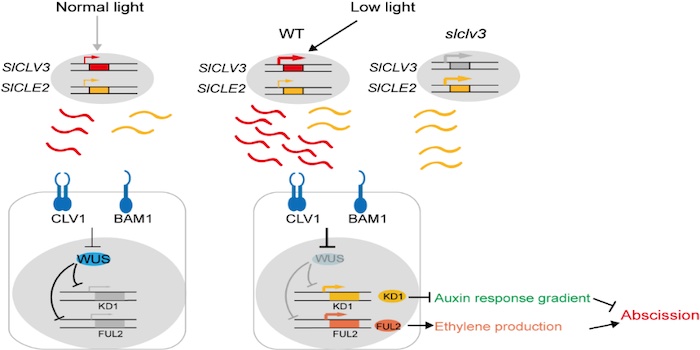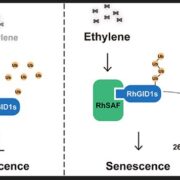SlCLV3-WUS regulates tomato flower abscission
Cheng et al. show that Low-light conditions stimulate the SlCLV3-SlWUS signaling module and regulate phytohormone homeostasis to induce abscission https://doi.org/10.1093/plcell/koac254
Lina Cheng, College of Horticulture, Shenyang Agricultural University, Shenyang, Liaoning 110866, People’s Republic of China.
Key Laboratory of Protected Horticulture of Ministry of Education, Shenyang, Liaoning Province, China.
Tao Xu, College of Horticulture, Shenyang Agricultural University, Shenyang, Liaoning 110866, People’s Republic of China.
Key Laboratory of Protected Horticulture of Ministry of Education, Shenyang, Liaoning Province, China.
Background: The abscission of plant reproductive organs occurs along a specific structure called the abscission zone (AZ), is triggered by developmental and environmental cues, and contributes to low crop yields. Environmental stimuli such as darkness and shade accelerate the abscission of flowers, flower buds, leaves, and immature fruits; this is associated with alterations in auxin and ethylene contents. Peptides might play a role in initiating abscission and regulating auxin and ethylene homeostasis during abscission.
Question: How do low-light conditions affect CLAVATA3 (SlCLV3) and WUSCHEL (SlWUS) to regulate phytohormone homeostasis and induce abscission in the important fruit crop tomato (Solanum lycopersicum)?
Findings: Low light stimulates the accumulation of SlCLV3 in the AZ and this SlCLV3 is perceived by the receptor kinases SlCLV1 and BARELY ANY MERISTEM1. After a series of signaling steps, SlWUS expression is repressed in the abscission zone. SlWUS negatively regulates abscission. Upon activation of the SlCLV3-SlWUS signaling pathway, the expression of the WUS target genes KNOX-LIKE HOMEDOMAIN PROTEIN1 and FRUITFULL2 is induced, the auxin response gradient in the AZ is disturbed, and ethylene production increases, leading to abscission. SlCLE2 can compensate for SlCLV3 function in regulating abscission.

Next steps: For the plant, impaired CLV3 signaling would lead to larger fruits by increasing locule number. Our results showed that CLV3 signaling mutants drop fewer flowers under low-light conditions. More flowers, along with larger and more fruit locules, and lower incidence of abscission during low-light conditions could contribute to greater yield.
Reference:
Lina Cheng, Ruizhen Li, Xiaoyang Wang, Siqi Ge, Sai Wang, Xianfeng Liu, Jing He, Cai-Zhong Jiang, Mingfang Qi, Tao Xu, and Tianlai Li (2022) A SlCLV3-SlWUS module regulates auxin and ethylene homeostasis in low light–induced tomato flower abscission. Plant Cell. https://doi.org/10.1093/plcell/koac254




